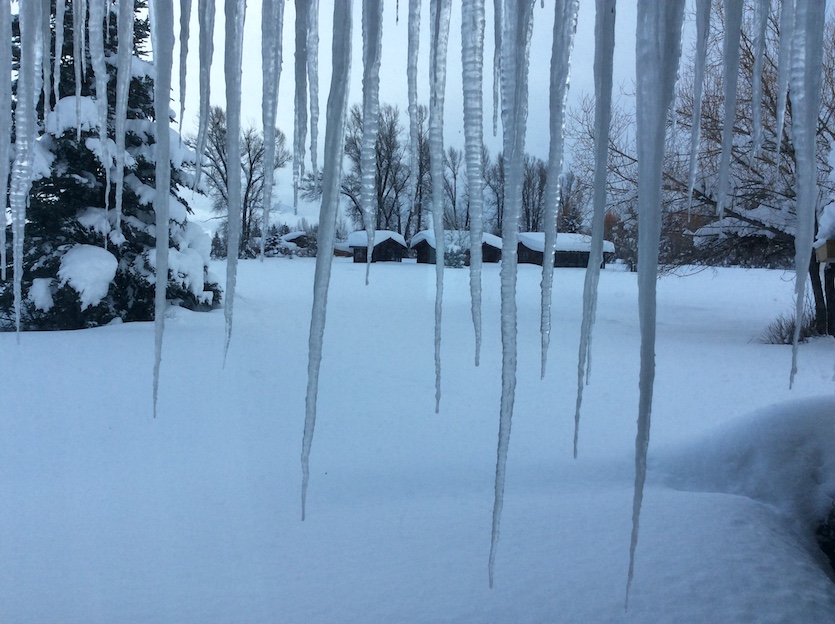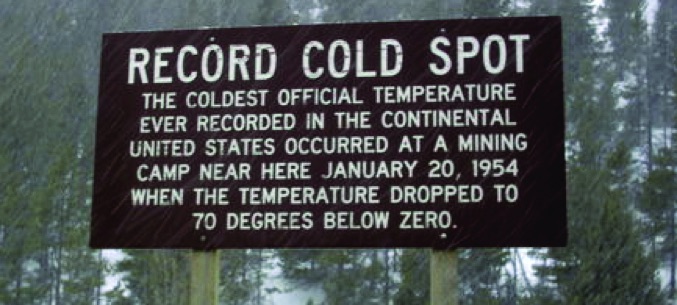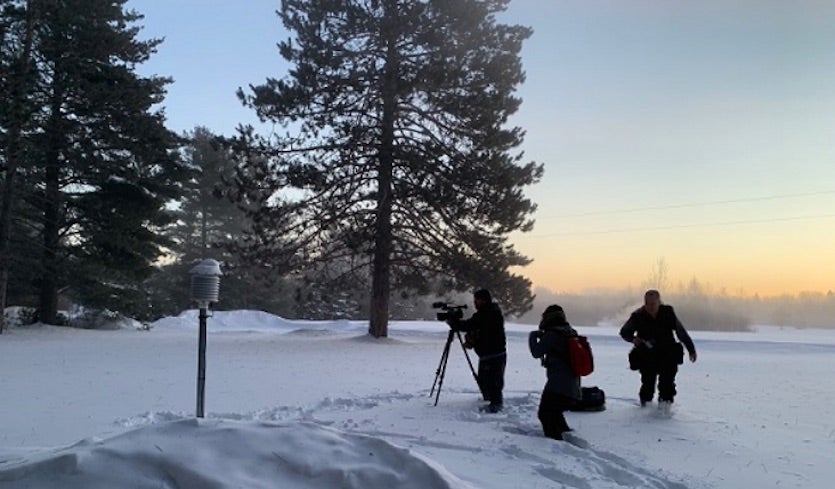| Above: Personnel from local and national media outlets check out the official NWS COOP temperature sensor in Cotton, Minnesota. The sensor measured a temperature of -56°F on January 27 and 31, 2019, the coldest readings in the contiguous U.S. since 1996. The site was also visited by NWS personnel from the Duluth office on the morning of January 31, 2019, to check on the quality of the instruments. They reported that “all of the equipment was in good working order”. The site is located on low ground near a river, which is a relatively new location for the Cotton COOP instrumentation (since late 2014). The former Cotton COOP site existed from 1962 to 2002. Image credit: NWS/Duluth. |
A series of arctic air masses invaded the northern portions of the U.S. Midwest and Plains in late January and early February, bringing the lowest temperatures observed in almost two decades to many sites from Wisconsin to Montana. I thought it opportune to look at what the coldest temperatures ever observed in the lower 48 states have been, with special attention to the coldest reading of all—the -69.7°F reported from Rogers Pass, Montana on January 20, 1954. Blog reader Scott Patterson, a resident of Colorado, has questioned the validity of this measurement, so I took a close look into the report.
The coldest of the cold places: -60°F or lower
Since the beginning of “modern” meteorological observations in the U. S. (circa 1875) only a handful of sites have officially measured temperatures of -60° or lower. Below is a list of the 15 that have achieved such. Only two sites—Maybell, Colorado, and Taylor Park, Colorado—have made the grade twice. Interestingly, Taylor Park reached -60°F on the same date in two different years: 1951 and 1985.
 |
| Figure 1. A version of this map appeared in my 2007 book Extreme Weather: A Guide and Record Book. |
Instances of -60°F in the Contiguous U.S.
-70° (actually -69.7°) Rogers Pass, Montana, Jan. 20, 1954
-66° Riverside Ranger Station (West Yellowstone, Montana) Feb. 9, 1933
-65° Fort Keogh (near Miles City), Montana, Jan. 13, 1888
-63° Moran, Wyoming, Feb. 9, 1933
-63° Poplar River, Montana, Jan. 1, 1885
-62° Darwin Ranch, Wyoming, Feb. 10, 1981
-61° Maybell, Colorado, Feb. 1, 1985
-61° Fort Logan, Montana, Feb. 11, 1899
-60° Tower, Minnesota, Feb. 2, 1996
-60° Maybell, Colorado, Jan. 1, 1979
-60° West Yellowstone, Montana, Jan. 12, 1963
-60° Taylor Park, Colorado, Feb. 1, 1951
-60° Taylor Park, Colorado, Feb. 1, 1985
-60° Island Park Dam, Idaho, Jan. 18, 1943
-60° Parshall, North Dakota, Feb. 15, 1936
-60° Boulder, Wyoming, Feb. 8, 1929
-60° Grayling (Hebgen Dam), Montana, Feb. 12, 1905
In addition to the NWS-certified readings above, Peters Sink, Utah measured -69.3° and nearby Middle Sink -61° on February 1, 1985, as part of an ongoing University of Utah research program into cold air drainage in the mountains of northeast Utah. An unofficial -64° was measured at Embarrass, Minnesota, on Feb. 2, 1996, and another unofficial -60° was reported from Rochford, South Dakota, on December 22, 1989.
 |
| Figure 2. These cabins, photographed in February 2019, were built in Moran, Wyoming by my grandfather in 1928 at his Three Rivers Ranch. The ranch was occupied during the extreme cold event of February 1933 when the temperature fell to -63° in Moran, tied for the fourth-coldest temperature ever measured in the contiguous U.S. Image credit: Tim Gallagher (current resident of the property). |
The runners-up: -55° to -59°
There have been, in addition to the 17 instances above, 34 instances of temperatures of -55° to -59° if we include the recent reports of -56° at Cotton, Minnesota on January 27 and 31, 2019. Prior to those instances, the most recent case of a temperature in this range was a -55° reading at Couderay, Wisconsin on February 2, 1996 (the same night as the -60° observation at Tower, Minnesota in list above).
Temperatures in the -50° to -54° range are far more frequent, with approximately 150 known instances of such in the official NCDC databases for contiguous U.S sites.
The question of the recent reports of -56° at Cotton, Minnesota
The National Weather Service Office in Duluth, Minnesota reported some exceptionally cold temperatures on the mornings of January 27 and 31, 2019, including a -56° reading at the COOP site of Cotton on both mornings and a -50° at the COOP site of Kabetogama on the 27th.
Other nearby locations were not quite so cold. The morning of January 27 produced a low of -46° at International Falls, which tied a similar temperature on January 21, 2011 as its coldest temperature on record at the current site, beaten by only a handful of readings in 1909 when the site was at a different location (-55° on January 6, 1909 being the coldest). The formerly perennial cold towns of Tower and Embarrass registered -44° and -45° respectively. The NWS-Duluth office mentioned in a wrap-up of the cold wave that since 1996 the sites in those two cities have been relocated after both observers retired and ever since they have not been reporting the kind of low temperatures that were common prior to the site changes.
Concerns about the Cotton value on the 27th arose from the fact that at the 7 a.m. usual observation time, a temperature of only -13° is shown, which would be hard to reconcile with an early morning low of -56°. In an email to me about this discrepancy, a meteorologist from the NWS/Duluth office (who visited the Cotton site on January 31) replied:
“Ah, I can understand the confusion! Cotton, MN is a cooperative observer site, which means that we only receive one report daily (usually around 7 am) with the max, min, and current temperature. These stations can have some quirks in reporting since they are all submitted manually by humans. In the case of Jan 27, the volunteer observer was out of town in the morning and sent in their report late at 1 pm instead of the usual 7 am, at which time they reported a low of -56 and a current temperature of -13. Looking at a map of area observations at that time the -13 seems to make sense for 1 pm.”
How reliable was the -70° reading from Rogers Pass, Montana on January 20, 1954?
Montana also experienced some of its coldest weather in years this February, with two -50° observations reported at Antelope 2W and Four Buttes 13NW on February 8. An unofficial -51° was measured at a RAWS site on the Canadian border called East Poplar River (not to be confused with the town of Poplar).
The official contiguous U.S. minimum temperature of -70° (actually -69.7°) was measured at Rogers Pass on January 20, 1954. The Rogers Pass COOP site was established on May 1, 1953, as a result of a new mine (the 4 K’s Mine) being dug by three brothers, the Kleinschmidts, and their nephew, H.M. Kleinschmidt, who was listed as the official weather observer. The COOP site and mine were closed on June 28, 1956, when it was determined that the ore was not of a sufficient grade to warrant further digging.
 |
| Figure 3. Location of Rogers Pass in western Montana (5610’ elevation). Background image credit: Alexrk2/Wikimedia Commons. |
Below is an account of the Rogers Pass record from 1954, penned by R.A. Dightman, Montana’s state climatologist at that time, who was personally responsible for the Weather Bureau’s handling of the matter for the Helena office. This account is excerpted from the December 1963 issue of Weatherwise magazine (pp. 272-273).
“Although the -70° minimum was observed on 20 January 1954, we in the Weather Bureau’s Helena office did not become aware of it until 3 February 1954, when the January records arrived by mail. In reviewing the Form 1009 data we noticed at once an entry of -68° as the 20 January minimum. Next we contacted the observer, asking him to send to us his minimum thermometer for checking and to provide any other information which might help us evaluate the observation—we had noticed immediately that -68°, if it stood up, was a new record, colder than the -66° at West Yellowstone (Riverside Ranger Station) on 9 February 1933.
“The observer’s reply was to send in not only the official minimum thermometer, but his own alcohol thermometer, with comment to the effect that he was awake most of the night of the severe cold because of loud and frequent “popping” noises in the cabin, and that about 2 am the 20th he had observed his thermometer (exposed outside an insulated window several inches from the building) to show about -68°. He then went to the official shelter, found the minimum indicating colder than -65°, which is as far down as the scale went, noting that the minimum index had retreated into the thermometer bulb. The fact that the two thermometers behaved, exactly as the observer described, when they were later tested in the laboratory in the Weather Bureau’s Instrument Division, was a very strong corroboration that his observation was correct.
“Both instruments were sent to the Instrument Division for checking. It was found there, duplicating in the laboratory the observer’s combination of observations, that the temperature actually was -69.7° at the point where the index reached the point in the bulb described by the observer for the official minimum, and the -68° he noted on his own instrument. These circumstances were sufficient evidence for adopting the -70° record, which still stands as the coldest observed within the continental 48 states. However, [‘furthermore?’] checking his record for the month with other stations (there were others of -57° [at Frazer] and -59° [at Thoeny] the same day) in the area. His changes [sic?] agreed very well with the general [weather] pattern, the record was well prepared, and the observer didn’t know he was observing the coldest on record--all small but significant points. Finally, the 20th of January 1954 had seen snow depth increase from 8 to 66 inches during the preceding 7 days, fresh invasions of Arctic air masses had occurred several times during the week and at the time of the coldest the sky was crystal clear, there was no wind—conditions were ideal for strong radiational cooling from the surface.
“There are no pictures of the station as far as we know. It was located in a small saucer-like depression just on the west side of the Continental Divide 1 mile south of Highway 20 and ¾ mile west of where the highway crosses Rogers Pass, lat 47°04’, lon 112° 22’, elevation 5470 ft above sea level.”
 |
| Figure 4. Highway sign marking the Rogers Pass record. Image credit: Montana Climate Assessment. |
Arguments against the Rogers Pass record
As we just saw, there is a very detailed account of the Rogers Pass record. However, WU reader and extreme weather enthusiast Scott Patterson has critiqued the validity of the record by making the following observations:
1. At the Rogers Pass station (station id 2471760) where the -70° was observed in January 1954, the next coldest reading ever recorded at the site was -37°.
2. There is a disconnect so far as the -70° reading when we compare the minimum temperatures observed to those of nearby Helena (35 miles distant and at an elevation of 3,830’):
Lowest Temp at Rogers Pass vs. Lowest Temp at Helena
Rogers Pass Helena
December 1953: 7° 10°
January 1954: -70° -36°
February 1954: 8° 11°
December 1954: -4° -8°
January 1955: -1° -13°
February 1955: -18° -11°
December 1955: -29° -15°
January 1956: -17° -25°
February 1956: -35° -31°
3. Rogers Pass, at the relatively low elevation of 5,600’, is not that cold of a location, especially by Montana standards (compared to the Yellowstone Plateau area and the northern and eastern Plains region of the state). Wikipedia has a climate table for a site 9 miles NNE of the original Rogers Pass site (where the -70° was observed). This site was established in 1964 and continues to operate. It is at an elevation of 4,430’ feet so we can deduce that the original Rogers Pass site (elevation 5,610’) temperatures averaged about 4°F cooler than the site represented in this Wikipedia table. Note that the data in the table is derived from a Western Regional Climate Center (WRCC) database but has been modified by Weatherbase to include the -70° extreme low temperature in January. In reality, the coldest January temperature on record at this particular location is -39° on January 27, 1986.
4. All of the other readings from the original Rogers Pass site, aside from the -70°, seem to be in line with other stations in western Montana for the period of record. In fact, a lot of the readings seem to be a bit too warm considering that this site was perhaps in a cold sink location (as per Mr. Dightman’s observation), which could have been an explanation for the extreme figure. For example, during a record-breaking late season cold spell in March 1955, why did Rogers Pass drop to ‘only’ -27° on March 25, 1955 when Helena registered -30° that morning?
Conclusion
Patterson’s points are all good ones, and they beg an explanation of just what kind of conditions might have prevailed the morning of January 20, 1954 to result in such an extreme reading. The best guess would be the “sink” theory. On that particular morning with clear skies, a calm wind, fresh fallen snow, and one of the coldest Arctic air masses ever to envelop Montana, all the ingredients were perfect for radiational cooling and cold air drainage.
Since the station’s period of record was so short (just three winters), this very well could have been a one-off event for that period of time at that specific site. In the March 1955 example, wind could have played a role in mitigating the cold air drainage effect at Rogers Pass.
Another point to consider: if the USWB Instrument Division Laboratory in Washington checked the instruments, what can explain the low reading apart from a legitimate low temperature? Could the miners been bored and wanted to play a practical joke? I suppose they could have used a magnet to force the slide down the tube in the minimum thermometer (!). In my opinion, that is a bit too far-fetched a theory to believe.
I’m not sure I have any good answers concerning the validity of the -70° figure, but given the detailed account of the record by Montana’s state climatologist, I doubt it will ever be officially reviewed again.
KUDOS: Thanks to blog reader Scott Patterson for bringing this to my attention.
Christopher C. Burt
Weather Historian




